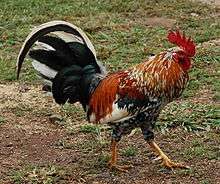Feral chicken

A family of feral chickens, Key West, Florida

A feral rooster on the island of Kauai
Feral chickens are derived from domestic chickens (Gallus gallus domesticus) who have returned to the wild. Like the red junglefowl (the closest wild relative of domestic chickens), feral chickens will take flight and roost in tall trees and bushes in order to avoid predators at night.
Feral chickens, like the wild red junglefowl, typically form social groups composed of a dominant cockerel, several hens and subordinate cocks. Sometimes the dominant cockerel is designated by a fight between cocks.[1]
Locations famous for feral chickens
- Bermuda
- Niue
- Fair Oaks, California
- Fitzgerald, Georgia
- Galston Gorge, Australia
- George Town, Cayman Islands, Grand Cayman
- Key West, Florida
- Gotha, Florida
- Kauai, Hawaii
- Los Angeles, California
- St. Augustine, Florida
- San Juan Bautista, California
- Houston, Texas
- Chicken Roundabout (A143) Bungay, Suffolk, UK [2]
- Port Chalmers, New Zealand
- Totton, UK
- St. Croix, St. Thomas, St. John, U.S. Virgin Islands
- New Orleans, Louisiana
- Oviedo, Florida
- Ybor City, Florida
See also
References
- ↑ Leonard, Marty L.; Zanette (1998). "Female mate choice and male behaviour in domestic fowl" (PDF). Animal Behaviour. 56 (5): 1099–1105. doi:10.1006/anbe.1998.0886. PMID 9819324. Retrieved 2008-04-25.
- ↑ Chicken Roundabout!
External links
- Chickens are Foragers, Not Fighters, By Karen Davis, PhD, United Poultry Concerns
- Chicken Roundabout!
- Chickens on White Oak Drive - HAIF
This article is issued from Wikipedia - version of the 5/27/2016. The text is available under the Creative Commons Attribution/Share Alike but additional terms may apply for the media files.
